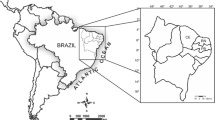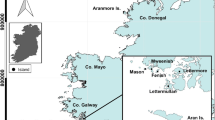Abstract
Macroalgae represent 26 % of the global production of cultivated organisms, with Gracilaria spp. representing 12 % of that production; Eucheuma spp. and Kappaphycus alvarezii account for 34 % of world’s algae production. Despite the potential for cultivating seaweed in Brazil, and with its more than 8000 km of coastline, there is neither marine algaculture nor detailed knowledge even among aquaculture farmers concerning the utility of algae in agriculture, industry, and gastronomy, with the result that algaculture represents only the smallest fraction of national aquaculture production. The main cultivated species of seaweed sold in Brazil include the exotic K. alvarezii and native species of Gracilaria that are grown on small scales and do not meet national industrial demands, which must be supplemented by imports. We discuss Brazilian algaculture here, pointing out some of the problems that restrict commercial production of algae in that country and offer solutions that could be shared with other nations.



Similar content being viewed by others
References
Amado-Filho G, Pereira-Filho GH (2012) Rhodolith beds in Brazil: a new potential habitat for marine bioprospection. Braz J Pharmacog 22:782–788
Araújo PG, Ribeiro ALNL, Yokoya NS, Fujii MT (2014) Temperature and salinity responses of drifting specimens of Kappaphycus alvarezii (Gigartinales, Rhodophyta) farmed on the Brazilian tropical coast. J Appl Phycol 26:1979–1988
Barros-Barreto MBB, Marinho LC, Reis RP, Mata CS, Ferreira PCG (2013) Kappaphycus alvarezii (Gigartinales, Rhodophyta) cultivated in Brazil: is it only one species? J Appl Phycol 25:1143–1149
Brasil (2016) Entenda a reforma ministerial e saiba como fica a Esplanada. http://www.brasil.gov.br/governo/2015/10/entenda-a-reforma-ministerial-e-saiba-como-fica-a-esplanada. Accessed 27 January.
Brennan W (2013) Cultivating change: women’s involvement in a Brazilian seaweed collective. Honors Projects. Paper 19. http://digitalcommons.macalester.edu/anth_honors/19
Bulboa CR, Paula EJ (2005) Introduction of non-native species of Kappaphycus (Rhodophyta, Gigartinales) in subtropical waters: comparative analysis of growth rates of Kappaphycus alvarezii and Kappaphycus striatum in vitro and in the sea in southeastern Brazil. Phycol Res 53:183–188
Bulboa CR, Paula EJ, Chow F (2007) Laboratory germination and sea out-planting of tetraspore progeny from Kappaphycus striatum (Rhodophyta) in subtropical waters of Brazil. J Appl Phycol 19:357–363
Buschmann AH, Varela D, Cifuentesa M, Hernández-González MC, Henríquez L, Westermeier R, Correa RA (2004) Experimental indoor cultivation of the carrageenophytic red alga Gigartina skottsbergii. Aquaculture 241:357–370
Capello FP, Menten MM, Manarim LK (2010) Mecanização racional. Brasil Hortifruti. CEPEA-ESALQ/USP 96:8–18
Castelar, B. (2006) estudo sobre a dispersão da macroalga exótica Kappaphycus alvarezii (Doty) Doty ex P. C. Silva, em cultivo comercial na Baía da Sepetiba, RJ, Brasil. Monograph. Universidade do Estado do Rio de Janeiro.
Castelar B, Reis RP, Bastos M (2009a) Contribuição ao Protocolo de Monitoramento Ambiental da Maricultura de Kappaphycus alvarezii (Doty) Doty ex P.C. Silva (Areschougiaceae - Rhodophyta) na Baía de Sepetiba, RJ, Brasil. Acta Botanica Brasilica. 23: 613-617
Castelar B, Reis RP, Moura AL, Kirk R (2009b) Invasive potential of Kappaphycus alvarezii off the south coast of Rio de Janeiro state, Brazil: a contribution to environmentally secure cultivation in the tropics. Bot Mar 52: 283–289.
Castelar B, Reis RP, Calheiros ACS (2015a) Ulva lactuca and U. flexuosa (Chlorophyta, Ulvophyceae) cultivation in Brazilian tropical waters: recruitment, growth, and ulvan yield. Aquacult Res 2015, 1-13.
Castelar B, Siqueira MF, Sanchez-Tapia A, Reis RP (2015b) Risk analysis using species distribution modeling to suport public policies for the alien alga Kappaphycus alvarezii aquaculture in Brazil. Aquaculture 446: 217–226.
Costa SW (1998) Cadeias produtivas do estado de Santa Catarina: aquicultura e pesca. EPAGRI Florianopolis, Brazil. Boletim Técnico n 97. 62p
Creed JC, Pires DO, Figueiredo MAO (2007) Biodiversidade Marinha da Baía da Ilha Grande. MMA/SBF, Brasília - DF
CRMV GO (2016) Instrução Normativa. Interministerial n° 6, de 31 de maio de 2004, http://www.crmvgo.org.br/legislacao/2_AQUICULTURA/040531_IN_inter_06.pdf.Accessed 15 January 2016
Dutra ARA, Garcia MA, Rossato IF, Barros Filho JRB (2011) A contribuição da ergonomia para a mecanização da produção catarinense de ostras. In: Proceedings ICIEOM-ABEPRO. pp 1-13. http://www.abepro.org.br/biblioteca/enegep2011_TN_STO_138_878_19175.pdf
FAO (2014) The state of world fisheries and aquaculture. Food and Agriculture Organization of the United Nations, Rome, p 243
FAO (2016). Commodity trade and production: quantity (t) http://www.fao.org/figis/servlet/SQServlet?file=/work/FIGIS/prod/webapps/figis/temp/hqp_8645407847772810809.xml&outtype=html. Accessed 27 January.
Freddi A, Aguilar-Manjarrez J (2003) Small-scale seaweed farming in North East Brazil. TCP/BRA/0065 35 FAO Aquaculture Newsletter 32
Ghilardi NP, Hayashi L, Berchez FAZ, Yokoya NS, Oliveira EC (2008) An alternative environmental monitoring approach for nonindigenous species introduced for maricultural purposes: the case of Kappaphycus alvarezii (Rhodophyta, Solieriaceae) cultivation in Brazil. Oecologia Brasiliensis 12:270–274
Góes HG, Reis RP (2011) An initial comparison of tubular netting versus tie-tie methods of cultivation for Kappaphycus alvarezii (Rhodophyta, Solieriaceae) on the south coast of Rio de Janeiro State, Brazil. J Appl Phycol 23:607–613
Góes HG, Reis RP (2012) Temporal variation of the growth, carrageenan yield and quality of Kappaphycus alvarezii (Rhodophyta, Gigartinales) cultivated at Sepetiba bay, southern Brazilian coast. J Appl Phycol 24:173–180
Hayashi L, Bulboa C, Kradolfer P, Soriano G, Robledo D (2014) Cultivation of red seaweeds: a Latin American perspective. J Appl Phycol 26:719–727
Hayashi L, Oliveira EC, Bleicher-Lhonneur G, Boulenguer P, Pereira RTL, Seckendorff R, Shimoda VT, Leflamand A, Vallée P, Critchley AT (2007) The effects of selected cultivation conditions on the carrageenan characteristics of Kappaphycus alvarezii (Rhodophyta, Solieriaceae) in Ubatuba Bay, São Paulo, Brazil. J Appl Phycol 19:505–511
Hayashi L, Santos AA, Faria GSM, Nunes BG, Souza MS, Fonseca ALD, Barreto PLM, Oliveira EC, Bouzon ZL (2011) Kappaphycus alvarezii (Rhodophyta, Areschougiaceae) cultivated in subtropical waters in Southern Brazil. J Appl Phycol 23:337–343
IBAMA (2016) Instrução normativa no 89, de 2 de fevereiro de 2006. http://www.ibama.gov.br/category/40?download=1265%3A89-2006-.p. Accessed 4 January 2016
IBGE (2016). Banco de dados Agregados. http://www.sidra.ibge.gov.br/bda/tabela/listabl.asp?c=3940&z=t&o=21. Accessed 15 January 2016.
ICMBIO (2016) Instrução Normativa IBAMA N° 185, de 22 de julho de 2008. http://www.icmbio.gov.br/cepsul/images/stories/legislacao/Instrucao_normativa/2008/in_ibama_185_2008_permitircultivokappaphycus_alvarezii_rs_sc_revoga_in_ibama_165_2007.pdf Accessed 4 January 2016.
INEA (2015) Diagnóstico do setor costeiro da Baía da Ilha Grande - Subsídios à elaboração do Zoneamento Ecológico-Econômico Costeiro. http://www.inea.rj.gov.br/cs/groups/public/documents/document/zwew/mdcz/~edisp/inea0073532.pdf Accessed 20 December 2015.
Leão ZMAN, Kikuchi RKP, Testa V (2003) Corals and coral reefs of Brazil. In: Cortés J (ed) Latin American Coral Reefs. Elsevier, Amsterdam, pp 1–52
Marinho-Soriano E (2005) Cultivo experimental de Gracilaria no Rio Grande do Norte,. In: Anais da X Reunião Brasileira de Ficologia Salvador 2004. Rio de Janeiro, Museu Nacional. Série Livros 10 pp 115-124
Marinho-Soriano E, Moreira WSC, Carneiro MAA (2006) Some aspects of the growth of Gracilaria birdiae (Gracilariales, Rhodophyta) in an estuary in Northeast, Brazil. Aquac Int 14:327–336
Marroig RG (2007) Epibiontes nas estruturas de cultivo de Kappaphycus alvarezii (Doty) Doty ex Silva na Baía de Sepetiba, RJ, Brasil. Universidade Santa Úrsula, Monograph
Marroig R, Reis RP (2011) Does biofouling influence Kappaphycus alvarezii (Doty) Doty ex Silva farming production in Brazil? J Appl Phycol 23:925–931
MDIC (2016). Dados oficiais do Governo Federal de importação de produtos muscilaginosos e espessantes de carragenina (Nomenclatura Comum do Mercosul – 13023910). http://aliceweb.mdic.gov.br//consulta-ncm/index/type/importacaoNcm. Accessed April 06 2016.
MPA (2013) Boletim Estatístico da Pesca e Aquicultura 2011, Ministério de Pesca e Aquicultura, MPA, Brasília
MPA (2016a) Plano de Desenvolvimento da Aquicultura - 2015/2020. http://www.mpa.gov.br/files/docs/Outros/2015/Plano_de_Desenvolvimento_da_Aquicultura-2015-2020.pdf. Accessed 2 January 2016.
MPA (2016b) Institucional. http://www.mpa.gov.br/institucional. Accessed 2 January 2016.
Neori A (2008) Essential role of seaweed cultivation in integrated multi-trophic aquaculture farms for global expansion of mariculture: an analysis. J Appl Phycol 20:567–570
Novaes ALT, Santos AA, Silva FM, Souza RV, Breda RR (2011) Colheita mecanizada de mexilhões (Perna perna) engordados a partir de coletores artificiais de sementes. Agropecuária Catarinense 24:38–41
Oliveira EC (2006) Seaweed resources of Brazil. In: Critchley AT, Ohno M, Largo DB (ed). World seaweed resources—an authoritative reference system. ETI BioInformatcs, Amsterdam. DVD-ROM
Oliveira EC, Paula EJ (2003) Exotic seaweeds: friends or foes? In Chapman, A.R.O.C., Anderson, R.J., Vreeland, V. & Davison, I.R. (eds). Proc. 17th Int. Seaweed Symp., Cape Town. Oxford Univ. Press, Oxford, Pp. 87-93
Olson DM, Denerstein E (2002) The Global 200: priority ecoregions for global conservation. Ann Mo Bot Gard 89:199–224
Ostrensky A, Borghetti, JR, Soto D (2007) Estudo setorial para a consolidação de uma aquicultura sustentável no Brasil, Curitiba
Paula EJ, Oliveira EC (2004) Macroalgas exóticas no Brasil com ênfase à introdução de espécies visando à maricultura. In: Silva JSV, Souza RCCL (eds) Água de Lastro e Bioinvasão. Editora Interciência, Rio de Janeiro, pp 99–112
Paula EJ, Erbert C, Pereira RTL (2001) Growth rate of the carrageenophyte Kappaphycus alvarezii (Rhodophyta, Gigartinales) in vitro. Phycol Res 49:155–161
Paula EJ, Pereira RTL (1998) Da “marinomia” a maricultura da alga exótica, Kappaphycus alvarezii (Doty) Doty ex. Silva (Rhodophyta) para produção de carragenanas no Brasil. Panorama da Aqüicultura 8:10–15
Paula EJ, Pereira RTL, Ohno M (1999) Strain selection in Kappaphycus alvarezii var. alvarezii (Solieriaceae, Rhodophyta) using tetraspore progeny. J Appl Phycol 11:111–121
Paula EJ, Pereira RTL, Ohno M (2002) Growth rate of the carragenophyte Kappaphycus alvarezii (Rhodophyta, Gigartinales) introduced in subtropical waters of São Paulo State, Brazil. Phycol Res 50:1–9
Patarra RF, Buschmann AH, Abreu MH, Neto AI (2014) Cultivo de macroalgas nos Açores. Oportunidades e desafios. Bol Soc Portuge Biotechnol série 2:16–18
Rebours C, Marinho-Soriano E, Zertuche-González JÁ, Hayashi L, Vásquez JÁ, Kradolfer P, Soriano G, Ugarte R, Abreu MH, Bay-Larsen I, Hovelsrud G, Rødven R, Robledo D (2014) Seaweeds: an opportunity for wealth and sustainable livelihood for coastal communities. J Appl Phycol 26:1939–1951
Reis RP, Bastos M, Góes HG (2007) Cultivo de Kappaphycus alvarezii no litoral do Rio de Janeiro. Panorama da Aqüicultura 17:42–47
Reis RP, Pereira RRC, Góes HG (2015) The efficiency of tubular netting method of cultivation for Kappaphycus alvarezii (Rhodophyta, Gigartinales) on the southeastern Brazilian coast. J Appl Phycol 27:421–426
Rodrigues IO, Silva MG (2011) Dinâmica populacional e rede coletora de esgoto In: IBGE (ed) Atlas de saneamento 2011, Brasilia, pp 249-252
Santos AA (2014) Potencial de cultivo da macroalga Kappaphycus alvarezii no litoral. Thesis, Univeridade de Santa Catarina
Santos AA, Costa SW (2015) Síntese informativa da maricultura 2014. EPAGRI. Santa Catarina State. Brazil.http://www.epagri.sc.gov.br/wpcontent/uploads/2013/08/Sintese_informativa_da_maricultura_2014.pdf. Accessed 15 Dec 2015
Suplicy FM, Vianna LFN, Rupp GS, Novaes ALT, Garbossa LHP, Souza RV, Guzenski J, Costa SW, Santos AA (2015) Planning and management for sustainable coastal aquaculture develompment in Santa Catarina State, south Brazil. Rev Aquacult. DOI: 10.1111/raq.12107
Viana LF, Novaes ALT (2011) Geocodificação de unidades de mapeamento aquícola para um sistema de controle de produção e rastreabilidade em Santa Catarina, Brasil. Geografia 36:163–178
Acknowledgments
The first author received a grant from the Conselho Nacional de Desenvolvimento Científico e Tecnológico (CNPq, 303582/2014-6).
Author information
Authors and Affiliations
Corresponding author
Rights and permissions
About this article
Cite this article
Reis, R.P., Castelar, B. & Santos, A.A.d. Why is algaculture still incipient in Brazil?. J Appl Phycol 29, 673–682 (2017). https://doi.org/10.1007/s10811-016-0890-8
Received:
Revised:
Accepted:
Published:
Issue Date:
DOI: https://doi.org/10.1007/s10811-016-0890-8




